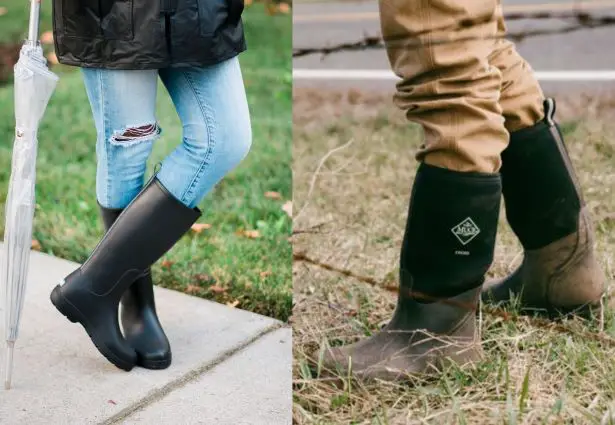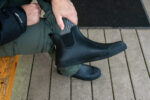Well both rain boots and muck boots are for the same purpose- to keep your feet dry from the external environment. We all know how nasty it can get working outside when it’s raining, especially if you’re working in a ranch or an environment where your feet can get wet and dirty easily.
Muck boots are hard, water-resistant boots that are also known as chore or work boots and it greatly resembles rain boots. However, the difference between both the boots is that muck boots are made to withstand water seepage and shield your feet in the muckiest of environments and are arguably twice as durable.

The word muck means dirt or grime and filth. Therefore, muck boots are exactly made to protect your feet from these factors. Whereas rain boots are primarily designed to keep your feet safe from water.
Let us see what similarities these boots have.
Muck Vs Rain boots: Similarities
1.) They keep our feet dry
Our feet stay dry thanks to rain boots and muck boots. Muck boots are a necessity for your closet because they can be worn in rain, mist, heavy dew, mud, and, of course, manure. Your feet and socks will appreciate it.
2.) Both the boots are made from similar material
Rain boots are frequently made of rubber or polyvinyl chloride (PVC), a halogenation polymer, while muck boots are typically made of neoprene, a type of aerated natural rubber that is also used to make marine survival suits.
3.) They are super durable
Both of these boots are meant to be durable because they are made to keep water, mud, and dirt off of your feet.
It also makes you feel better while you’re working hard outside on a rainy day to know that your feet are covered by a strong pair of boots that can withstand the elements.
4.) They are versatile boots
One of the best things about rain and muck boots is how well they perform in just about any environment, be it rainy, dirt, ranch or farmland.
They are manufactured in such a way that no matter the harsh conditions, these boots will not disappoint you when it comes to feet protection.
5.) Superior traction
We all know that both these boots are made to shield our feet from rain or mud and dirt, therefore, their soles are designed in a way to provide excellent grip so that you don’t trip and fall.
6.) Insulation
Not all muck boots and rain boots provide insulation, it depends on the type of model you’re going for. However, there are some that come with insulation to keep your feet warm and toasty. Just have a proper look at the features before you make a purchase.
7.) Comfort
It’s important to think about your comfort when it comes to muck and rain boots because your feet need to feel comfortable in harsh conditions.
Cheap muck or rain boots are typically made of solid rubber, and while they may keep your feet dry, they don’t offer enough support for walking.
It’s a wise investment to purchase a pair of comfortable muck or rain boots if you intend to wear them frequently.
Now look at the differences between muck and rain boots.
Muck Vs Rain boots: Differences
1.) Durability
The very first difference between rain and muck boots is their durability. While rain boots last for a long time, they’re not as durable as muck boots according to some reviews.
However, you can be assured that both these boots are decently durable and will last you a very long time.
2.) Applications
While rain boots are primarily employed to shield your feet from rain, muck boots are made to protect you from more such elements like mud, sludge, slime and all other sorts of muck.
Muck boots are designed for the farm, wet factory floors, or muddy trails, whereas rain boots are a little bit more casual and are best for skipping through puddles and navigating wet city streets.
3.) Height
Usually, rain boots are shorter. Given that they typically end just above the knee. The average height of a rain boot is somewhere between 15.5- 16″.
Whereas, muck boots are comparatively taller when it comes to height. The average height of muck boots is somewhere between 17.5- 18″. However, it all depends on the model and brand.
Here is a quick reference chart for you.
| Features | Rain boots | Muck boots |
| Material | Rubber (PVC) | Rubber (neoprene) |
| Durability | Good | Excellent |
| Height | 15.5 to 16 inches | 17.5 to 18 inches |
| Applications | For use in rain | For use in rain, mud, dirty surfaces |
| Insulation | On some models | On some models |
| Traction | Good | Good |
| Cost | Affordable | They are affordable, but a little costlier than rain boots. |
| Price range | $30- $100 | $50- $150 |
Types of Rain boot
1.) Tall rain boots- The knee-high rain boot is one of the traditional designs of rain boots that you’ll recognize. These little ones will keep your entire leg dry on even the windiest of days, making them perhaps the most useful of the bunch. (Tall vs Short Rain Boots: Which One is Better?)
2.) Short rain boots- Consider the short rain boot if you’re looking for the most simple rain boot design. It’s a great option when you want something a little lighter but still weather-resistant because it is lightweight in nature.
3.) Chelsea rain boots- These boots are ideal when you’re in a hurry as they are simple pull-on boots. They are practical for casual use but not while you’re at work.
4.) Moto rain boots- With straps, studs, and chunky soles, moto rain boots are more for fashion than for practical use.
Types of Muck boots
1.) Hunting- As the name suggests, these types of muck boots are specifically for hunting purposes which requires your footwear to not be loud and efficient in a wild and rough environment.
2.) Fishing- Fishing requires your hands and feet to get dirty, as there is a lot of water and mud involved. Therefore, you require a muck boot which is apt for a fishing environment.
3.) Gardening- While gardening isn’t as rough and dirty as fishing, still you require proper boots to keep the soil and mud away from your feet.
4.) Cattle farming- It involves a lot of dirt and animal dung that can come in contact with your hands and feet as you might frequently step in some animal poop lying around.
Therefore, muck boots designed especially for ranches and cattle farms will keep your feet away from these.
5.) Outdoor chores- Muck boots are also known as chores boots as it is versatile footwear that can be used for all round work that requires your feet to get wet or dirty.
Any outdoor work that involves your feet being drenched in a muddy or wet surface, muck boots are your best friend.
Recommended Rain and Muck boots
1.) Muck Chore Soft Toe Rubber Work Boots
- 4 mm neoprene provides comfort and flexibility, along with excellent waterproofing, shock absorption and heat retention properties; adjusts to your foot shape to resist blisters and chafing
- XpressCool fabric lining pulls moisture away from skin to keep feet cool and dry in warm weather; comfort rated from 40 °F to 95 °F (4 °C to 35 °C)
- 100% waterproof work boots; Spandura treatment offers maximum abrasion resistance; etc Sockliner reduces friction and heat build up
- Steel shank for support; Vibram rubber outsole for traction on varied terrain; 16-inch height for added protection
- Triple toe and quadruple rubber heel reinforcement for extra protection and durabilty
Prices pulled from the Amazon Product Advertising API on:
Product prices and availability are accurate as of the date/time indicated and are subject to change. Any price and availability information displayed on [relevant Amazon Site(s), as applicable] at the time of purchase will apply to the purchase of this product.
These boots are sturdy and useful that fits in on any ranch or farm. These boots are comfortable and feature a steel shank and a sturdy rubber outsole.
Initially, these boots were thought to be useful mainly in the rain and snow, but once you realize how cozy and convenient they are to put on and take off, you’ll use them for a variety of chores.
2.) Muck Hi-Cut Boot
- 2mm thermal foam under the footbed for extra warmth
- Extended rubber overlay for extra protection
- Breathable mesh lining wicks away humidity and perspiration, allowing air to travel throughout the boot
Prices pulled from the Amazon Product Advertising API on:
Product prices and availability are accurate as of the date/time indicated and are subject to change. Any price and availability information displayed on [relevant Amazon Site(s), as applicable] at the time of purchase will apply to the purchase of this product.
In the muddiest conditions, this field boot keeps you warm, dry, and comfortable. The air mesh lining allows your feet to breathe whether you’re out on the farm or trudging across frozen fields.
They have a rubber calf-high exterior that shields against sticks, rocks, and scratches.
3.) BOGS Classic High-M Waterproof Rain Boots
- The product is 100% waterproof
- Natural hand-lasted rubber and a four way stretch inner bootie
- Non-slip non-marking and self-cleaning outsole.
- Contour fit for maximum support and movement
- Comfort rated from temperate to -40˚F or sub-zero condition
Prices pulled from the Amazon Product Advertising API on:
Product prices and availability are accurate as of the date/time indicated and are subject to change. Any price and availability information displayed on [relevant Amazon Site(s), as applicable] at the time of purchase will apply to the purchase of this product.
These boots are great for wading through snow, mud, or deep puddles because they are simple to put on and take off. On your feet, they feel incredibly plush and cozy.
Additionally, they are quite warm when you’re moving around because of the neoprene insulation. However, they are a little heavier because of the insulation.
4.) TIDEWE Rubber Work Boot with Steel Toe
- Reliable Protection
- Waterproof & Anti-Slip
- Comfortable & User-Friendly
- Multi-Use
Prices pulled from the Amazon Product Advertising API on:
Product prices and availability are accurate as of the date/time indicated and are subject to change. Any price and availability information displayed on [relevant Amazon Site(s), as applicable] at the time of purchase will apply to the purchase of this product.
These boots come with great features like you can work without worrying that your toes will be crushed by falling heavy tools thanks to steel toe caps.
It also comes with a reinforced rubber casing that offers additional security. Made with 100% waterproof rubber with a 6mm neoprene layer that is supple and permeable.
FAQs-
Can you wear muck boots in snow?
Since muck boots are completely waterproof, you won’t have to worry about melted snow getting inside your boots because the majority of muck boots have an internal liner to keep your feet warm.
Check your muck boots temperature rating if the surrounding temperature drops below freezing.
Can you wear rain boots in the snow?
Most rain boots do not come with insulating features. However, the ones that do can provide warmth in moderate temperatures.
But when the temperature drops below freezing level, your rain boots might not be sufficient enough to keep your feet warm.
See also: Rain Boots Vs Snow Boots
Conclusion
Both muck and rain boots offer amazing protection against external conditions, and they are quite similar to each other except for a few key differences.
However, you need to do thorough research on the features they provide according to the type of job you will be employing them in.











